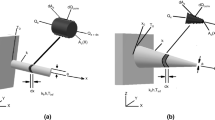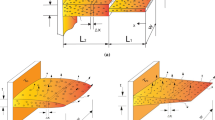Abstract
Compared to a smooth channel, a finned channel provides a higher heat transfer coefficient; increasing the fin height enhances the heat transfer. However, this heat transfer enhancement is associated with an increase in the pressure drop. This leads to an increased pumping power requirement so that one may seek an optimum design for such systems. The main goal of this paper is to define the exact location and size of fins in such a way that a minimal pressure drop coincides with an optimal heat transfer based on the genetic algorithm. Each fin arrangement is considered a solution to the problem (an individual for genetic algorithm). An initial population is generated randomly at the first step. Then the algorithm has been searched among these solutions and made new solutions iteratively by its functions to find an optimum design as reported in this article.
Similar content being viewed by others

References
Wang G, Stone K, Vanka S P. Unsteady heat transfer in baffled channels[J]. ASME Journal of Heat Transfer, 1996, 118:585.
Patankar S V, Liu C H, Sparrow E M. Fully developed flow and heat transfer in ducts having streamwise-periodic variations of cross-sectional area[J]. ASME Journal of Heat Transfer, 1997, 99:180.
Bemer C, Durst F, McEligot D M. Flow around baffles[J]. ASME Journal of Heat Transfer, 1984, 106:743.
Webb G W, Ramadhyani S. Conjugate heat transfer in a channel with staggered ribs[J]. International Journal of Heat Mass Transfer, 1985, 28:1679.
Patankar S V, Kelkar K M. Numerical prediction of flow and heat transfer in a parallel plane channel with staggered fins[J]. ASME Journal of Heat Transfer, 1987, 109:25.
Cheng C H, Huang W H. Numerical prediction for laminar forced convection in parallel-plate channels with transverse fin arrays[J]. International Journal of Heat Mass Transfer, 1991, 34:2739.
Guo Z, Anand N K. Three dimensional heat transfer in a channel with a baffle in the entrance region[J]. Numerical Heat Transfer, 1997, A31:21.
Habib M A, Mobarak A M, Sallak M A, Abdelhadi E A, Affify R I. Experimental investigation of heat transfer and flow over baffles of different heights[J]. ASME Journal of Heat Transfer, 1994, 116:363.
Bazdid-Tehrani F, Naderi-Abadi M. Numerical analysis of laminar heat transfer in entrance region of a horizontal channel with transverse fins[J]. International Comm Heat Mass Transfer, 2004, 31:211.
Yang Y, Hwang C. Calculation of turbulent flow and heat transfer in a porous-baffled channel[J]. International Journal of Heat Mass Transfer, 2003, 46:771.
Bejan A, Pfister P A. Evaluation of heat transfer augmentation techniques based on their impact on entropy generation[J]. Letters Heat Mass Transfer, 1980, 7:97.
Ayhan T, Karlik B, Tandiroglu A. Flow geometry optimization of channels with baffles using neural networks and second law of thermodynamics[J]. Computational Mechanics, 2004, 33:139.
Bejan A, Morega A M. Optimal arrays of pin fins and plate fins in laminar forced-convection[J]. AMSE Journal of Heat Transfer, 1993, 115:75.
Abu-Nada E. Numerical prediction of entropy generation in separated flows[J]. Entropy, 2005, 7:234.
Al-Sarkhi A. Comparison between variable and constant height shrouded fin array subjected to forced convection heat transfer[J]. International Comm Heat Mass Transfer, 2005, 32:548.
Rakshit D, Balaji C. Thermodynamic optimization of conjugate convection from a finned channel using genetic algorithms[J]. Heat Mass Transfer, 1992, 41:535.
Knight R W, Goodling J S, Gross B E. Optimal thermal design of air cooled forced-convection finned heat sinks: experimental verification[J]. IEEE Trans Comp Hybrids Manufacturing Tech, 1992, 5:754.
Campo A. Heat removal of in-tube viscous flows to air with the assistance of arrays of plate fins Part I: theoretical aspects involving 3-D, 2-D and 1-D models[J]. International Journal of Numerical Methods Heat Fluid Flow, 2000, 10:334.
Campo A, Rodriguez F. Approximate analytic temperature solution for uniform annular fins by adapting the power series method[J]. International Comm Heat Mass Transfer, 1998, 25:809.
Santos N B, de Lemos M J S. Flow and heat transfer in a parallel-plate channel with porous and solid baffles[J]. Numerical Heat Transfer A, 2006, A49:471.
Blazej Z. Finding the winning strategy for a poker playing program an application of genetic algorithm in a poker game[DB/OL]. http://ib-poland.virtulave.net/ee/genetic1/3_genetic algorithm.htm.
Holland J H. Genetic algorithms[J]. Scientific American, 1992, 4:44.
Mousavi S S, Hooman K. Heat and fluid flow in entrance region of a channel with staggered baffles[J]. Energy Conversion and Management, 2006, 47:2011.
Author information
Authors and Affiliations
Corresponding author
Additional information
Communicated by ZHOU Zhe-wei
Rights and permissions
About this article
Cite this article
Mousavi, S.S., Hooman, K. & Mousavi, S.J. Genetic algorithm optimization for finned channel performance. Appl. Math. Mech.-Engl. Ed. 28, 1597–1604 (2007). https://doi.org/10.1007/s10483-007-1206-z
Received:
Revised:
Issue Date:
DOI: https://doi.org/10.1007/s10483-007-1206-z



